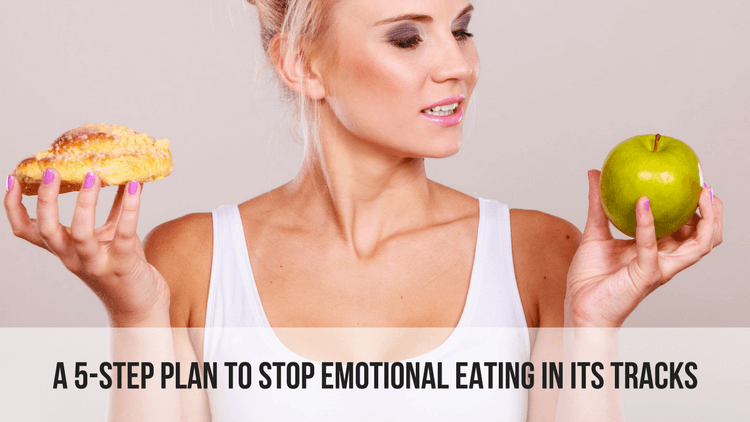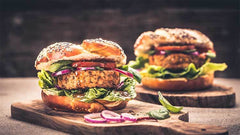
How to Stop Emotional Eating - A 5-Step Plan that Can Help You
At a basic level, food is what fuels our bodies. We need it to stay alive. However, many people think of food in an emotional way because food is at the center of so much in our lives: Celebrations, loss, and other events.
The problem with food is that many people use it to fill emotional voids or tackle other complicated problems in their lives. Many people eat when they’re unhappy, which exacerbates the negative emotions that prompted them to eat in the first place. This can lead to a vicious circle which many are unable to overcome on their own.
How to Stop Emotional Eating
In this article, we detail a 5-step process you can follow if you’re frustrated with your own emotional eating habits and want to move on to a healthier, more positive relationship with food.
Step 1: Take a step back and think about why you’re eating
Emotional eating strikes quickly. If you’re feeling both emotional and hungry, it’s all too likely that you’ll automatically go to the fridge, grab whatever looks good at the time, and eat it.
The best way to handle such an automatic response is to slow down your reaction. Instead of feeling hungry and allowing your emotions to guide your decisions and following what comes naturally, take a minute to analyze what you’re feeling.
Often, slowing down reveals that though you feel hungry, it isn’t because of your stomach, it’s because of your mind. Taking just 30 seconds to one minute to process your thoughts, hunger, and feelings is all it takes for some to see whether the hunger is real or is a product of emotion instead.
Typically, your hunger will be tied to emotions. Evaluate how you’re feeling and consider what’s happening at that moment that’s prompting your response. Did something prompt these emotions? What are you actually feeling? What do you want to eat to deal with these feelings? Typically, if it’s a negative emotion, you’ll want something sweet or salty to feel better, not an apple or other healthy snack.
Being thoughtful is the simplest way to stop emotional eating at the source. However, it may not always work, depending on how strong the emotion is. That’s why it’s important to follow all five steps of this five-step plan.
Step 2: Write down what you eat and why
A food journal is a great idea for any type of weight loss and is particularly useful for those who eat emotionally.
Your food journal can be in a notebook, on your computer, or anywhere that works for you. The idea is to track your hunger − including when it occurs, how it feels, what you’re feeling when you feel it, and why you believe you’re feeling that way. Questioning why you’re feeling how you are is most important because it will help you to better understand the root cause of your emotions.
One of the best places to start is with a “cravings” journal. If you feel an intense craving, you should journal what you want, your feelings at the time, why you believe you’re feeling like you are, and how you could satisfy your cravings without food.
Read: 5 Ways To Keep Your Motivation Fire Burning When Losing Weight >>

Step 3: Decide what to do
After you’ve paused, then journaled, you’re faced with the next step: Making a decision.
Your decision should ideally stem from whether you’ve identified the hunger as physical or emotional. If you aren’t able to readily identify where your hunger is coming from, you should be able to either put it off until your next meal or, if it’s been a while since you’ve eaten, eat a healthy snack or begin preparing your next meal.
If your hunger is emotional, you’ll feel compelled to eat something right away. You should try to handle this hunger the same way you handle physical hunger. But if you can’t fight the cravings, you can:
- Eat something without ruining your diet. If you’re craving something sweet, you can satisfy your cravings without choosing the worst option. For example, you could grab a piece of fruit instead of a cookie.
- Do something instead of eating. Instead of eating, fill the emotional need in another way. If you feel lonely, call a friend or spend time with a pet. If you’re feeling anxious, take a relaxing bath. If you’re feeling bored, go for a walk or run. There is always something you can do instead of eating.
- Satisfy your cravings in moderation. If you just can’t resist your craving, give in, but don’t go overboard. Let’s say you want a cookie: Choose a small cookie, and eat it slowly. Maybe take a few bites and re-evaluate how you feel. Doing so is a good way to control cravings and still make progress on ending the cycle.
Step 4: Consider how you feel after eating
Thinking about what you ate is another simple way to overcome emotional eating habits. Wait 15 minutes after you’ve eaten and then ask yourself whether you feel guilty or satisfied. If you feel guilty or unhappy, consider what you can do differently next time. The goal is to learn from your mistakes without getting frustrated or upset with yourself.
You should add these feelings to your food journal after the entry to help you formalize your feelings and recognize this problem in the future.
Step 5: Confront your feelings
Every time you get to Step 4 in this plan and feel upset, it’s important to create an action plan for the future. If you feel the same feelings that triggered a prior response, you can go back and reference it and look at the alternatives you’ve brainstormed and used successfully in the past.
If the feeling causing the emotional eating is one that is repetitive, you’ll need to address the feeling head-on. For example, if a relationship is causing your discomfort, you may want to consider ending the relationship or talking to the other person about what’s wrong. You can do this with any scenario, whether it be personal or professional.
Equip yourself with a plan to end emotional eating
Emotional eating doesn’t have to control your life or sabotage your efforts to lose weight. Take control with the 5-step action plan above and get on the path to better understanding yourself, your emotions, and the root cause of the problems you’re experiencing.
Doing so will make you happier and healthier and keep you on track with your weight loss goals!




